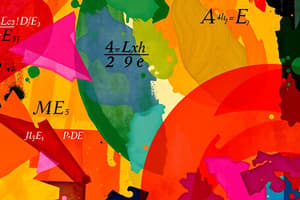Podcast
Questions and Answers
What happens to patient radiation dose when kVp is reduced to increase image contrast?
What happens to patient radiation dose when kVp is reduced to increase image contrast?
- Patient radiation dose decreases significantly.
- Patient radiation dose becomes negligible.
- Patient radiation dose increases. (correct)
- Patient radiation dose remains unchanged.
The probability of an x-ray undergoing the photoelectric effect is related to which factor?
The probability of an x-ray undergoing the photoelectric effect is related to which factor?
- The third power of the atomic number of the tissue. (correct)
- The mass density of the tissue.
- The square of the atomic number of the tissue.
- The energy of the x-ray.
How does Compton scattering probability relate to x-ray energy?
How does Compton scattering probability relate to x-ray energy?
- It increases with higher x-ray energy.
- It remains constant regardless of x-ray energy.
- It is directly proportional to the atomic number of tissue.
- It decreases with increasing x-ray energy. (correct)
What is the relationship of the probability of the photoelectric effect to x-ray energy?
What is the relationship of the probability of the photoelectric effect to x-ray energy?
What does mass density refer to?
What does mass density refer to?
Which two x-ray interactions are most important to radiology?
Which two x-ray interactions are most important to radiology?
What results in image noise during an x-ray examination?
What results in image noise during an x-ray examination?
What is the term for the difference between x-rays absorbed and those transmitted?
What is the term for the difference between x-rays absorbed and those transmitted?
What produces the lighter areas in a radiograph?
What produces the lighter areas in a radiograph?
Which anatomical structures are primarily represented by the dark areas in a radiograph?
Which anatomical structures are primarily represented by the dark areas in a radiograph?
Approximately what percentage of incident x-rays reach the image receptor?
Approximately what percentage of incident x-rays reach the image receptor?
What is essential for producing a high-quality radiograph?
What is essential for producing a high-quality radiograph?
What type of x-rays primarily contribute useful diagnostic information to the radiograph?
What type of x-rays primarily contribute useful diagnostic information to the radiograph?
Flashcards
Photoelectric effect
Photoelectric effect
X-ray absorption proportional to the cube of the atomic number of the tissue.
Compton scattering
Compton scattering
X-ray scattering independent of atomic number, probability decreases with energy.
Differential absorption
Differential absorption
Difference in X-ray absorption between tissues.
Mass density
Mass density
Signup and view all the flashcards
kVp and patient dose
kVp and patient dose
Signup and view all the flashcards
Radiopaque
Radiopaque
Signup and view all the flashcards
Radiolucent
Radiolucent
Signup and view all the flashcards
X-ray Interaction
X-ray Interaction
Signup and view all the flashcards
Image Noise
Image Noise
Signup and view all the flashcards
kVp
kVp
Signup and view all the flashcards
Study Notes
Differential Absorption
- X-rays interact with matter in five ways: coherent scattering, Compton scattering, photoelectric effect, pair production, and photodisintegration
- Only two interactions are critical to radiology: Compton scattering and the photoelectric effect
- Two x-ray production methods are crucial: bremsstrahlung and characteristic x-rays.
- X-rays that pass through the body without interaction are more significant for creating an image than those that interact through scattering or absorption
- Image formation depends on the difference between x-rays absorbed photoelectrically by the patient and those transmitted to the image receptor. This difference is called differential absorption
- Approximately 1% of incident x-rays reach the image receptor
- Radiographic images come from about 0.5% of the x-rays emitted
- Differential absorption increases as the kVp decreases
- Higher quality radiographs require proper kVp selection for optimal x-ray energy for maximum differential absorption
- Reducing kVp to enhance differential absorption increases patient radiation dose
X-Ray Interactions
- Compton scattering contributes no information to the image; it results in image noise, making the image less clear
- Techniques and apparatus are used to reduce scattered x-rays reaching the image receptor
- X-rays that undergo photoelectric interaction provide diagnostic information
- Photoelectric absorption produces the light areas in a radiograph, corresponding to areas with high x-ray absorption
- These areas are radiopaque, meaning they absorb more x-rays
- Transmitted x-rays create dark areas in a radiograph, representing structures through which the x-rays pass, which are called radiolucent
Dependence on Atomic Number
- The probability of photoelectric effect is proportional to the third power of the atomic number of the tissue
- Bones have a higher atomic number, causing more x-rays to be absorbed via the photoelectric effect, resulting in lighter areas in the image
Dependence on Mass Density
- Mass density is the quantity of matter per unit volume
- Mass density is sometimes measured in g/cm³
- X-ray interaction with tissue is directly proportional to the tissue's mass density, regardless of the type of interaction
Summary Table(Mass Density)
| Substance | Mass Density (kg/m³) |
|---|---|
| Lung | 320 |
| Fat | 910 |
| Soft Tissue/Muscle | 1000 |
| Bone | 1850 |
| Air | 1.3 |
| Barium | 3500 |
| Iodine | 4930 |
Studying That Suits You
Use AI to generate personalized quizzes and flashcards to suit your learning preferences.
Related Documents
Description
Explore the essential interactions of X-rays with matter that impact radiology, focusing on Compton scattering and the photoelectric effect. Understand the significance of differential absorption in image formation and the factors that affect radiographic quality. This quiz is designed to assess your knowledge on these fundamental concepts in radiology.




